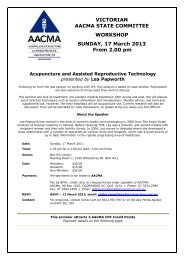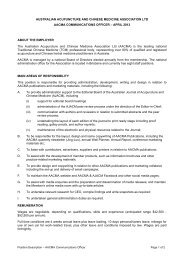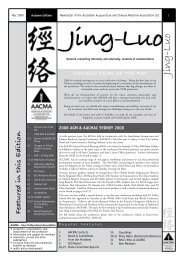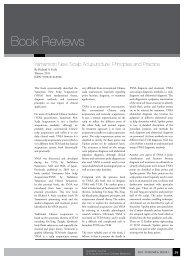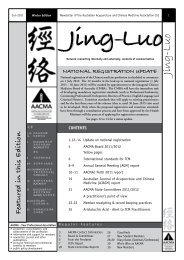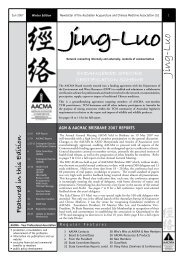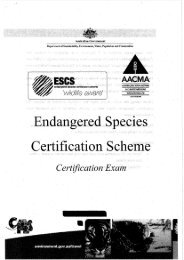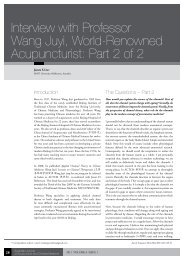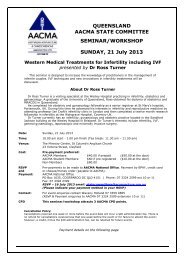Fire and Ice - Australian Acupuncture & Chinese Medicine ...
Fire and Ice - Australian Acupuncture & Chinese Medicine ...
Fire and Ice - Australian Acupuncture & Chinese Medicine ...
- No tags were found...
You also want an ePaper? Increase the reach of your titles
YUMPU automatically turns print PDFs into web optimized ePapers that Google loves.
<strong>Fire</strong> <strong>and</strong> <strong>Ice</strong>JL McDonaldeffect moxibustion may have remains an open question. Anearlier animal study by Wang <strong>and</strong> Xie also showed an antiinflammatoryeffect of moxibustion in experimentally inducedadjuvant arthritis in rats. 22OsteoarthritisBrosseau et al. conducted a Cochrane systematic review ofthree studies, of which two involved osteoarthritis of theknee, while the third related to post-surgical rehabilitationafter total knee arthroplasty. 23 No significant difference wasfound between ice packs <strong>and</strong> control (untuned short wave) inrelieving pain. 23 Knee oedema associated with osteoarthritisshowed no significant improvement from ice massage; however,post-surgical knee oedema did improve significantly from tensessions of ice packs. 23 The application of hot towels did notreduce post-surgical knee oedema significantly. 24 Curiously,the reviewers made no comment on whether or not heat waseffective in relieving pain or improving range of movement.Low back painA Cochrane systematic review by French et al. comparedsuperficial heat <strong>and</strong> superficial cold for low back pain, includingboth acute <strong>and</strong> sub-acute low back pain. 25 Of nine includedstudies, only three related to cold treatment, <strong>and</strong> these werejudged to be of such poor quality that no conclusions couldbe drawn. 25 The reviewers concluded that there is moderateevidence for the effectiveness of heat wraps <strong>and</strong> heatedblankets in reducing pain <strong>and</strong> disability in the short term. 25One trial also suggested that adding exercise to heat wraps gaveeven better pain relief for acute <strong>and</strong> sub-acute low back pain. 25Studies making comparisons between cold <strong>and</strong> heat for lowback pain yielded conflicting evidence. 25Moxibustion researchWhilst moxibustion is a form of heating therapy, it is notnecessarily the case that all forms of heating therapy can achievethe same results as moxibustion. Some specific therapeuticclaims have been made for moxibustion which have not beenmade for any other form of heating therapy. Shen et al. citeresearch which shows moxibustion to be capable of enhancing‘physiological <strong>and</strong> immune functions’. 26 Toguchi cites thefindings of various Japanese researchers on moxibustion <strong>and</strong>lists the following therapeutic actions of moxibustion: 27• produces histotoxin (‘beneficial for neuralgia <strong>and</strong>rheumatism’),• regulates intestinal peristalsis,• promotes local vasodilation <strong>and</strong> enhances localmicrocirculation,• promotes recovery from muscular fatigue,• increases leucocyte count as well as leucocyte w<strong>and</strong>eringspeed <strong>and</strong> phagocytotic action,• increases production of erythrocytes <strong>and</strong> haemoglobin.Other moxibustion studies (a mixture of animal <strong>and</strong> human, invivo <strong>and</strong> in vitro studies) have also suggested that moxibustionhas the following effects:• anti-inflammatory, 21,22,28,29• anti-oxidative, 29-31• anti-allergic, 28• immune-enhancing. 26-30The application of moxibustion in all the above studies wason a selected acupuncture point or points, not locally on thesite of a musculoskeletal injury or disorder. So, although someearly evidence outlined above does suggest that moxibustionmay have an anti-inflammatory action when used systemically,this does not tell us whether local moxibustion is capable ofa similar action. Unless further research suggests otherwise, atpresent it would seem prudent to follow the traditional rule ofnot using moxa on any local area which is red <strong>and</strong> hot.Summary of research‘More large, well-constructed studies needed’ is almost a clichétoday in reviews of acupuncture <strong>and</strong> moxibustion research.However, it appears from the research reviewed above that thesame can probably be said of many forms of cryotherapy whichare currently in widespread use, <strong>and</strong> which are recommendedin many clinical practice guidelines. While it appears there isgood evidence that ice can cause vasoconstriction <strong>and</strong> reducedtemperature in local tissue, the evidence for oedema reductionis contradictory. <strong>Ice</strong> does produce local numbness but this isnot the same as analgesia – it is local anaesthesia. 7 No evidencewas found to support the assertion that ice can relieve musclespasm.It is noteworthy that the studies which showed the best clinicalresults for ice tended to be for acute soft tissue injury, especiallyof the ankles <strong>and</strong> knees. The quality of studies of ice treatmenton the low back was so poor that reviewers were unable to drawany conclusions, <strong>and</strong> no studies were found involving the useof ice on the neck. This may be because muscular problems ofthe neck are more often seen in chronic states <strong>and</strong> most of theclinical practice guidelines for the use of ice restrict its use to theacute inflammatory stage of a soft-tissue injury (nominated bysome as the first 72 hours). For acute <strong>and</strong> sub-acute low backpain, heat wraps <strong>and</strong> hot blankets were found to be effective inshort-term pain relief <strong>and</strong> reduction of disability. No researchwas found which evaluates the use of moxibustion alone forlow back pain, but this is hardly surprising as moxibustion isusually used in conjunction with acupuncture in the treatmentof low back pain.For rheumatoid arthritis, reviewers found no good evidence ofbenefit from either heat or cold; however, some moxibustion<strong>Australian</strong> Journalof <strong>Acupuncture</strong> <strong>and</strong> <strong>Chinese</strong> <strong>Medicine</strong>2007 VOLUME 2 ISSUE 2



